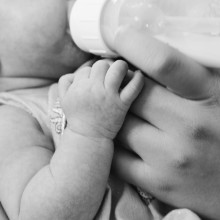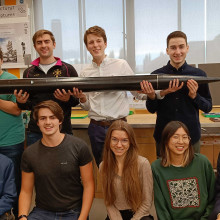The mercury rises as record temperatures are recorded across the world. But what’s driving them? Also ahead: the sound of silence. We’ll be finding out why scientists think it’s not just the absence of noise, we can actually perceive it. Plus, the Cambridge students who are hoping to boldly go where no other amateur European rocket group has been before...
In this episode

00:54 - What caused the hottest day on record?
What caused the hottest day on record?
Roshan Salgado D'Arcy
The world is warming at an alarming rate, with climate experts suggesting that the 4th of July was the hottest day on Earth in more than 100,000 years, and the El Niño weather phenomenon is almost certainly making things worse. The heatwave sweeping southern Europe at the moment has been so intense that the Italian Meteorological Society has dubbed it Cerberus, after the three-headed monster that features in Dante's inferno. Roshan Salgado D'Arcy is a science communicator who’s doing a PhD looking at climate communication.
Roshan - We've got to be really careful about pinpointing climate change as a specific cause of any particular weather event. And this is no different. There's two ways we can answer what's causing this heatwave. The first is the very technical answer, which goes into things about atmospheric physics, air pressure. In a very literal sense, it's caused by a high pressure area of air sitting on top of Europe. But if you take a more big picture, a holistic earth system perspective, you can think of it in terms of energy. And that's where the climate change element comes in. Because our weather system and our climate is driven by the amount of energy available to the atmosphere and the oceans. And what we are effectively doing is trapping more and more energy in the atmosphere in particular because of our emission of carbon dioxide predominantly. We are giving more energy to natural systems. So we can't say specifically that this heat wave is caused directly by climate change, but we can absolutely say that we have given it more energy to exacerbate the heat further.
Chris - And the role of El Nino, what is that and how might it contribute not just here, but beyond?
Roshan - So, El Nino is a natural phenomenon which would occur with or without climate change. If you think of it in terms of energy, a basic description is that it is the movement of energy, specifically heat, from the oceans to the atmosphere. And specifically that's the Pacific Ocean. So as far as El Nino's role in the current European heat wave, it's very hard to draw a direct link because El Nino's direct effects are almost always concentrated around the Pacific. But of course the Pacific is a huge, huge ocean. It takes up a ridiculously large chunk of Earth's surface. So inevitably it has effects all over the world. So on a local level, for example, El Nino tends to cause a lot more heavy rainfall along the west coast of America, but it also dries out on the other side of the Pacific, say around Indonesia. But as far as linking it to the heatwave is concerned, it's much harder to make that connection. But of course, coming back to the point about energy, by releasing this energy from the ocean into the atmosphere, it can almost certainly play some kind of role. But it is also worth mentioning that the full effect of El Nino won't be really felt until later this year. So it's still only just getting going.
Chris - And in human terms, what are the consequences, both short and long term, of these extreme weather situations that we are experiencing?
Roshan - Well, on a very tangible level, it literally has killed people. So a study came out this week, in fact, which looked at heatwaves from last year, 2022, specifically in Europe. And it found that approximately 60-61,000 people died as a direct result of heatwaves in Europe. That's not an insignificant number.
Chris - What did they die of?
Roshan - It's all kinds of heat related effects. Heat stress for example, dehydration are probably the two main factors. Heat has physiological effects on the body and the human body can only survive up to so much heat. And we are seeing temperatures in the 45 degrees plus in Europe, which is insane. And that is pushing the limits of what human beings can survive. You don't want to be exposed to that for too long.
Chris - So what should be on the priority list for policymakers?
Roshan - Well, here's the thing, it's not going to get better, and that sounds really pessimistic, but all the heat we've seen so far is locked into the system. So it's going to keep getting worse until we get to a point where we stop putting CO2 into the atmosphere. So that is the biggest take home message: we have to get to net zero as fast as possible because that's the only way we'll stop this getting worse.

05:37 - Babies use a 'greedy gene' to control mum
Babies use a 'greedy gene' to control mum
Amanda Sferruzzi-Perri, University of Cambridge
A new study has shown that babies use a ‘greedy’ gene in the placenta that connects the developing baby to its mother to ‘remote-control’ the mum’s metabolism into feeding them extra food before they are born. We - and the mice used in the study - inherit copies of this gene from both our parents, but only the version that comes from dad is turned on. Amanda Sferruzzi-Perri studies fetal and placental physiology at the University of Cambridge…
Amanda - The placenta is connected to the foetus, and within the foetal blood there are messages communicating foetal demands for nutrients. So the amazing thing about the placenta is it's responding to both the mother and the foetus at the same time to try and control how the foetus is growing to best grow it healthy and large enough, but without compromising the mother.
Chris - So the placenta is sensing what the baby needs, the developing baby, and it's sensing what the mum's got to give away. And if there's a disparity, then it's going to provoke the mother to liberate more resources so that it meets the demands of the developing baby?
Amanda - That's right. And that's exactly what we tried to test. We selectively altered the signalling cells in the placenta that are responsible for communicating that need of the foetus to the mother.
Chris - Do you know what the nature of the signal is? What is the message that the developing baby is putting into the mum to make her liberate more energy and so on?
Amanda - Yeah. We identified several hormones that we think are really important in mediating this communication with the mum. They regulate the way in which the mother's tissues produce and respond to insulin, which is a key hormone that controls glucose and fat levels in the mother's circulation during normal pregnancy. A critical thing that the mother has to undergo is to reduce her ability to respond to insulin. And so the hormones that are coming out of the placenta are causing lowered insulin sensitivity so that the mother's liver, her skeletal muscle, her fat tissue doesn't suck up those nutrients. Instead they're made available in the circulation so they can be transferred to the foetus for growth.
Chris - So what happened when you shut off the ability of the placenta to make that signal?
Amanda - The mum held onto more nutrients, particularly glucose and lipids, and she used them instead for her body. And what that meant was that the foetus received fewer nutrients. They were born smaller. And surprisingly, when we looked at the health of the baby as it grew older, we found that they also had problems themselves in terms of their metabolism in later life.
Chris - Biologists often talk about a conflict between what the dad wants and what the mum wants because dad wants the biggest, healthiest, bounciest baby that he can breed in that mum to have the greatest chance of survival. And the mum wants the easiest baby she can give birth to with less cost to her health. So is that part and parcel of what you're seeing here, that argument?
Amanda - Yeah, it actually is. And you raised a really important point: the one way in which we studied this was to manipulate or alter the expression of the particular gene that is turned on when it is inherited from the dad. And actually, if you delete that gene from the placental signalling cells, the mum didn't free up the sugars, the lipids and the foetus was born growth restricted. And so we were able to really study this conflict between the parents operating at the level of the placenta, which was important in governing foetal growth.
Chris - So that's fascinating. You can inherit that gene from your mum and you can inherit it from your dad, but when you inherit it from your dad, it seems to have this effect of liberating resources from the mum. And if you turn it off, it stops that happening, but not the version you get from your mum?
Amanda - No, and that's because the mother's copy is normally turned off. And these types of genes are really unique. It's a small proportion of all the genes that we express in our body, but in this case, the gene is called IGF2. It's only turned on if we inherited it from our dad.
Chris - Wow. And given the relevance of insulin and diabetes in pregnancy, because some women succumb to gestational diabetes they develop a diabetic state when they are pregnant, it does have implications for their health later in life, is that tied up to this as well then?
Amanda - It is. And interestingly, women who develop gestational diabetes may have overproduction of hormones from the placenta. And there's also some data that suggests that if the copy of IGF2, this important gene in the placenta that is turned on from the father, if that's produced even more in pregnancy, there is a greater chance that the mother will develop diabetes in pregnancy.

11:55 - Can we hear silence?
Can we hear silence?
Rui Zhe Goh, Johns Hopkins University
‘The sound of silence.’ Sounds like an oxymoron, doesn’t it? Well, a new study published this week in the journal PNAS suggests Simon and Garfunkel might have been onto something. James Tytko reports.
James - Philosophers have been grappling with a problem for centuries. If silence is just an absence of sound, a nothingness, why is it that it can be so emotive? For example, a rest in a powerful piece of music...
< Opening to Beethoven's 5th>
James - Or ducking into a quiet space from a busy street. Just as a well-placed full stop, paragraph break or chapter ending in a novel can have a profound effect, so too a dramatic pause in a powerful speech or piece of music often communicates something through nothing.
Rui Zhe - And it does seem like as the audience, we feel these silences, right? Like these silences don't just seem to be the absence of experience, but a positive thing. That's a positive experience that's being felt.
James - Rui Zhe Goh is a researcher in philosophy and psychological and brain sciences at Johns Hopkins University in America. And studying silence with science presents some challenges...
Rui Zhe - Silence has no pitch. It has no loudness. And so it is not clear what the scientific method can zoom in on to study this phenomenon.
James - To address this, Rui Zhe and other scientists in the field have to rely on illusions of time. A famous example is the so-called 'one is more' illusion, and it's one I can demonstrate now with you as the test subject. You're about to hear two beeps followed by one beep. Your task is to identify which is longer: The first two beeps combined or the longer beep. Here you go:
Robot Voice -
One (two beeps with a gap of silence) Two (One beep, no gap)
James - So which was longer? The first two beeps together are the longer beep on its own. Here it is again...
Robot Voice - One, two.
James - Now subjects overwhelmingly judge the one long beep as longer than the two short beeps, but in fact, they're exactly the same length.
Rui Zhe - The sound waves that we hear are just continuous waves of sounds without obvious discrete breaks. But what we perceive are discrete sounds. So we don't just perceive a continuous jumble of sound waves, but we perceive discretised sounds such as words or musical notes. And the process that makes this possible is this process called event segmentation, where our auditory system breaks discontinuous input into discrete representations. And this process of event segmentation is thought to be underlying this one is more illusion.
James - And you might be able to see where this is going. Using the theory of event segmentation, Rui Zhe's intuition was to invert the one is more illusion by substituting the silence with sound and vice versa.
Rui Zhe - And if these moments of silence trigger the same auditory process that happens with sound, then we have evidence that the auditory system can produce experiences with silence.
James - So let's have another go. We're going to repeat the experiment, but with silences instead of beeps cutting through ambient noise in a bustling restaurant. It's the same format as last time, two short silences followed by a longer silence. Which seems longer overall? <Two periods of silence>
James - Now I'm still interpreting the two shorter silences as being faster than the longer silence. And it turns out I'm not alone.
Rui Zhe - The results of our experiment was that subjects judged the one silence to be longer than the sequence of two silences, and that the proportion of subjects that did so were exactly the same as the proportion of subjects that judged the one sound as longer than the two sounds. Our results about silence challenge common conceptions of perception, of hearing more specifically. We generally think that perception is about seeing stuff out there in the world. Where we hear things, there must be a sound for us to hear. When we see things, there must be objects out there for us to see. But what our results seem to suggest is that our auditory system can produce a perceptual experience even when there's nothing out there in the world to be perceived.
James - What next? Have you got any follow up questions or research planned to enhance our understanding of this topic even further?
Rui Zhe - I think it's still an open question whether we can positively hear pure silence not in contrast with sound, such as silences heard during meditation or silences heard when it's late at night and you're gazing at the stars and there's no sound. We also have ordinary experiences of visual absences such as when something moves across your visual view and then suddenly disappears. And we have some current work trying to ask whether the one that is more illusion also happens with visual disappearances.
James - Well, we anticipate the findings of that study with a lot of interest.
Rui Zhe - Thank you so much.

17:39 - Hobbyists hope to make spaceflight history
Hobbyists hope to make spaceflight history
Jamie Russell, University of Cambridge
A team of Cambridge students are aiming to become the first amateur group in Europe to send a rocket into space. It’s hoped that the Griffin I module will pass the Karman line, which is the 100 kilometre boundary between Earth's atmosphere and outer space. Jamie Russell is the president of the Cambridge University Spaceflight Society...
Jamie - We've actually been around for quite a long time, longer than some of the other space flight societies. It all started with the goal of some high altitude balloons. However, obviously we've come a long way since then, since sending the teddy bear into space, which I think is our most famous mission from that era. Since then, we've launched three rockets in the Martlet series, these were just on the back of some solid rocket motors that you can buy if you go to the right shop. Only now we are starting to develop our own liquid fueled rocket engines, these are by-propellant engines, and we've been testing those and we realise, particularly over Covid, when we had lots of time to design, we actually could send this mission to space on the back of our own engine. So we call this new engine White Giant, it develops 32 kilonewtons of thrust and runs on ipa, Isopropyl alcohol, and liquid oxygen.
Chris - H how big are the rockets?
Jamie - The Martlet series that I mentioned, they were relatively small, but I don't want to say that they are small. They're about four metres tall, so two people stacked on top of each other, so they're pretty, pretty big things.
Chris - Where would you launch them? Where do you do this?
Jamie - The first one was launched in Scotland, actually. But the latter two, we had to go to America for those ones, just for legal reasons. Essentially, the launch ceilings in this country are more limiting than over there. Particularly, there's rules to do with which types of materials, like if you want too many metals. So we went to America, that was in California and we launched in the Mojave Desert. It's really fun.
Chris - Did you have to take the rocket there or did you design here and build some stuff remotely?
Jamie - We designed and built everything in Cambridge back then, and still do. And let me tell you, it's a bit of a logistical challenge to get everything there on time. You've got one weekend to do everything, set everything up and it has to work. So yeah, we're currently preparing to launch another rocket in September time and yes, it's a logistical nightmare to get everybody there and get all of the rocket parts there. And obviously when you're in the Mojave Desert, if you need one bolt and you don't have it, then you're a bit stuck.
Chris - Do you get it back? Do you have a recovery or retrieval system for this rocket or is it a one hit wonder and you've got to start from scratch every time?
Jamie - For this rocket we're launching in September, we do expect to be able to soft land it. It's got a fully custom recovery system that we've designed and built and tested in the Dyson Center at the university's engineering department. So we do expect it to land slowly.
Chris - On a parachute?
Jamie - Onto a parachute, yeah, it should land at about 20 miles an hour. So everything should be just fine. However, there's a lot of risk associated with space flights, and so we think it'll work, however we shouldn't expect it to return. There's no one hundred percent here at all.
Chris - How high will that one go?
Jamie - Aquilo will be going to three kilometres.
Chris - So it's 3% of the way to where you want to be, but presumably you start small, and you solve problems incrementally until you go for the big one?
Jamie - So it's the logistical challenges.There's the challenge of manufacturing and learning how all those processes work and interacting with what we call 'cots' components, commercial off the shelf components. So interacting with those is quite difficult. And this is just a little learning experience on the way to that big goal that we've got at the end of the road.
Chris - And how long before we're at the point where you are making a genuine shot for space, as in a hundred kilometres up?
Jamie - Well, of course we need the motor for that. I mentioned White Giant - we hope to be testing that in December. And once you've got the motor, the rest of the rocket is 'relatively', I'm using big air quotes here, straightforward. So you can expect it to happen not too far after that. I'm reluctant to put a firm date on that. But the engine is the real cornerstone of this that we really need to get right first.
Chris - So you solve the guidance, the other materials side of it. So you know you've got something that flies, it flies in a straight line and you can track and recover and so on. And then it's a question of packing a bigger and bigger engine in to give it more of a kick to get it higher?
Jamie - So Griffin will be a completely bespoke rocket. It won't be similar to Aquila, but there's a couple of parts that we are designing for Aquila that we've taken strong inspiration from. But everything will be bespoke for Griffin designed around this huge motor, 32 kilonewtons, that's three tons of force. We'll be accelerating at 5G off the pad. Everything will be bespoke for that, but it's mostly a case of just multiplying things, although there's a lot of challenges associated with going 4,000 miles an hour.
Chris - It's quite quick, isn't it? So how do you track it? Have you got telemetry aboard? Are you beaming signals back? Have you got some cameras on there so you can get gratuitous pictures of what it looks like on the way up and so on?
Jamie - Yeah. So cameras will definitely be there. We have to design special mirrors to keep them out of the air flow, because the air outside is 600 degrees C as we're going through it so fast.
Chris - Because it's compressing and therefore heating?
Jamie - Exactly, yes. We're going so quickly that the compression wave is formidable really.
Chris - So that would be like if you put your hand out of a car window and you were doing 4,000 miles an hour, your hand would get hundreds of degrees.
Jamie - Hundreds of degrees.
Chris - Do you have something to deflect the airstream around the camera then, so you can still see?
Jamie - Yeah, that's a requirement, but also the rest of the rocket has to be designed to withstand these kinds of temperatures. I mentioned 600 degrees, that's actually warm enough to melt aluminium. And most aluminium alloys won't stand up to that, but we want to make the rocket out of aluminium, so we have to go through all of these solutions and so we're actually looking at phenolic resins, but this is a whole other research area.

23:56 - How do tennis players select which ball to use?
How do tennis players select which ball to use?
James - When we're in a match on our first serve, we're looking for the newest ball because basically that's going to fly through the air a lot quicker, a lot faster, and the serve is the most important shot and you dictate the point from the serve. On my second serve, I'm looking for a ball that's a bit more fluffed up, a slightly older ball that's going to travel through the air slower because what I want to actually do is get my second serve in with a bit of spin. And then I want to be able to trade rally points and then build the point to then be able to win it. So with the first serve, I'm looking for a quick serve, a flat serve, the second serve is going to be less in place, give my opponents some variety, not the same serve, not the same look all the time. And that's how we decide as tennis players, what balls we are going to use. So you might see Andy Murray at Wimbledon and he'll pick up three or four balls and he'll chuck a couple of balls away, but his first ball will be the newest ball because that is the most important shot. Get a short return and then build on that and maybe come into the net to volley to finish the point.
Rhys - So how are you recognising the differences between the balls? What is it that you're spotting on the balls?
James - Okay, so I'd be looking for the print on the balls, how new that looks for a first serve. On a second serve, I may be looking for a little bit more wear on the ball logo and definitely some more fluff on the outside of the ball. If you can see this ball here's got a little bit more fluff around the edge of the ball, so that's going to be a bit slower. That's going to be my second serve ball. And then this ball here hasn't got so much fluff on it and it's going to travel through the air quicker. So I'll be looking to hit a first serve with that ball.
Rhys - And when the players are discarding the balls, what is it that they're doing? Is it psychological? Is that science involved? Are they trying to find a ball that they maybe won a previous point with?
James - Andy Murray is a great example of this. He's super fussy over the balls. If he's won a point with the ball, he'll deliberately ask the ball boy or the ball girl for that ball. It's definitely psychological. I think if you've won a point, you're like 'right, gimme that ball back. That's a good ball.' Self-confidence is huge.










Comments
Add a comment